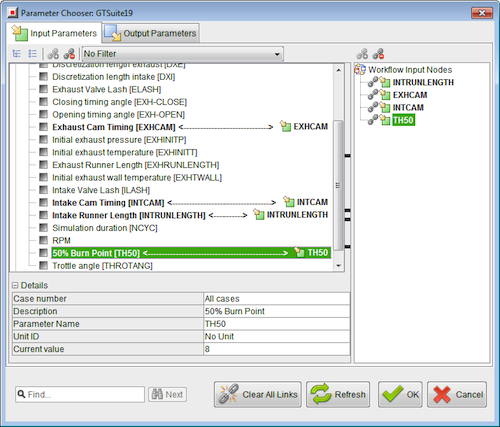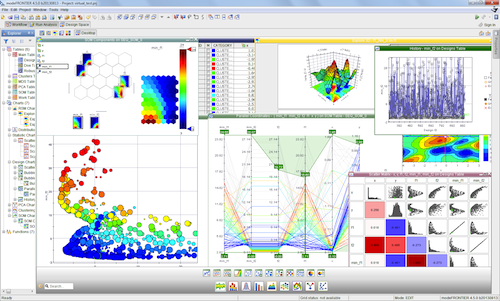Latest News
August 15, 2013
Simulation is a complex enough design process, but when you start to branch out into multi-objective optimization and then even further into multi-disciplinary design studies, the exercise is fraught with complexity. Working with an arcane design tool won’t help.
In the latest release of its modeFRONTIER integration platform for multi-objective and multi-disciplinary optimization, ESTECO is aiming to simplify the inherent complexity of what the tool seeks to accomplish. Stocked with an array of new features company officials bucket under the categories of usability, control, reuse, and confidence, the forthcoming modeFRONTIER 4.5 version aims to improve the user experience, increase engineering productivity, and shorten the overall design cycle.
“What we are focused on in 2013 for development is trying to reduce complexity in the workflow,” explains Marco Carriglio, ESTECO’s support and services engineer. “Companies are under extreme pressure and more people are accustomed to using simulation in their daily work. We’re trying to improve the usability of the interface and help engineers reduce the complexity during their work day.”
The newest release ushers in a variety of enhancements in the area of usability. One of the more prominent additions is the Parameter Chooser, which makes it easier to integrate third-party tools, or nodes as they’re called in the ESTECO world. The Parameter Chooser, which functions as the editor to detect input and output parameters defined within a given model (for example, the parameters of a CAD model), simplifies the process of building the workflow. Users simply choose different design parameters and modeFRONTIER variables, and the tool automatically establishes links and creates the new nodes directly. There is also the possibility of linking more than one input node to the same variable as well as new FIND and FILTER functions, to simplify the process of finding variables based on name or data type.
While there was automation around node integration in earlier releases, the process remained fairly labor intensive and time consuming, notes Carriglio. In comparison, the new Parameter Chooser reduces the workflow around node integration to as little as one-third the time of previous releases, he says.
modeFRONTIER 4.5 has also been totally revamped from a user interface perspective to improve accessibility and again, simplify what inevitably remains a very complex workflow. Drag and drop palettes and simplified preference panels are designed to help users find critical information and resources in a faster way. For example, users can organize charts by category and type in the name of a specific graphic to find what they are looking for. They can also organize charts into a favorites list so they can be found and reused more easily as opposed to starting from scratch for every simulation.
A single command bar along the top of the main window changes based on the environment selected, aiding in navigation. Common actions—for example, new, load, save, import/export, or print—are maintained across environments while unused actions automatically are removed from the command bar. Enhancements to the Explorer tree on the left side of the interface allow for ease of navigation in the cases where projects have hundreds of nodes as part of a workflow or hundreds of charts in the DesignSpace.
The Run Analysis environment has undergone the most complete transformation, with the idea of helping engineers exert more control over these complex multi-disciplinary optimizations. A flexible and customizable dashboard, enriched with intelligent graphic tools, allows real-time monitoring of the design evaluation progress while a wide range of gadgets will automatically update as the optimization advances, providing useful insights into process performance. “What we wanted to provide is a dock for decision making so everything an engineer needs is at their fingertips,” Carriglio explains.
In the category ESTECO dubs “confidence” are improvements to the Multi Criteria Decision Making (MCDM) tool, which helps engineers resolve problems that involve multiple and conflicting goals. Rewritten as a wizard-based solution, users can now execute a chain of decision making, starting from a design table with a lot of optimized designs (for example, a Pareto front) or an already calculated MCDM function.
By adjusting some parameters characterizing the design problem (defining weights for each attribute, for example), the MCDM will extract good designs and classify them to generate a complete ranking of the best-in-class designs for comparison purposes. Using interactive features such as sliders, engineers make adjustments to the design and its ranking is updated in real-time.
modeFRONTIER 4.5 will ship in September.
The video below is an example of how ESTECO’s software is being used. In this case, it is used in conjunction with National Instruments’ LabVIEW to optimize the power consumption of a robotic arm.
Subscribe to our FREE magazine, FREE email newsletters or both!
Latest News
About the Author
Beth Stackpole is a contributing editor to Digital Engineering. Send e-mail about this article to [email protected].
Follow DE







